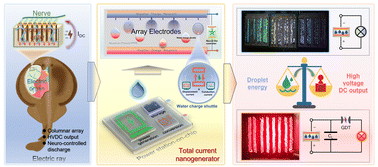A bio-inspired total current nanogenerator†
Abstract
Conventional nanogenerators typically employ displacement current as the driving force to output alternating current (AC). It is thus inevitable to face a series of complex power management issues, such as AC–DC conversion and AC phase asynchrony, leading to a bulky, inefficient and costly energy harvesting system. Here, inspired by the electricity generation mechanism of electric rays, a high-performance droplet-based nanogenerator on the basis of solid–liquid contact electrification is developed, which employs both displacement current and conduction current as the driving forces to output high-voltage direct current (DC) without a rectifier. This new device, defined as a total current nanogenerator, has the characteristics of compact array architecture, high-voltage DC output, and controllable energy release, successfully realizing the voltage-controlled electric shock process. Since the output voltage of the developed nanogenerator is as high as 3000 V, a single discharge is sufficient to light up more than 1260 LEDs, demonstrating its unparalleled capability for harvesting high-entropy water energy. The total current nanogenerator proposed in this work provides new insights into the theory and technology of energy harvesting from solid–liquid interfaces.



 Please wait while we load your content...
Please wait while we load your content...